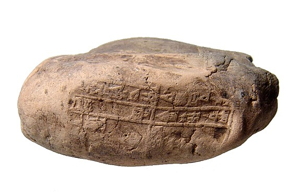 |  |  |
The Sumerian civilisation was the source of cuneiform script, the earliest known alphabetic writing system arising in the period prior to 3,500 BC in the fertile plain of Mesopotamia between the Tigris and Euphrates rivers. The characters were shaped in a manner suitable to the medium being impressed on clay using wooden “stamps”. The number system developed within this script was based on powers of sixty rather than powers of ten as in contemporary systems. Even so, these ‘sexagesimal’ numbers were constructed with patterns corresponding to the numbers from 1 to 10. During the period of Akkadian rule, which lasted to 2100 BC, the abacus entered Sumerian life creating a further extension to the capacity to form basic arithmetic operations. The Babylonian civilisation replaced that of the Sumerians around 2000 BC.
The clay tablet (or in this case tag) in this collection is about 4,000 years old, from the “middle chronology” of the Old Babylonian civilisation (1934–1924 BC), and displays cuneiform characters for both numbers and the alphabet.
A preliminary partial translation has been generously provided by Dr Robert Englund, principal investigator at the Cuneiform Digital Library Initiative at the University of California at Los Angeles. Dr Englund notes that this is a tag receipt for 1 ewe and 1 ram, fallen (ri-ri-ga), possibly from mar(dumu)-ihur (but this needs confirmatory translation by an expert on Old Babylonian administrative script). It is “a very nice catch” because the tag was originally on a string, and because the seal indicates the receiving party was important being almost certainly dedicated to King Lipit-Ishtar of Isin (… / lugal kal-ga / x i3-si-in). Given this, the tag is from the “middle chronology” with the text dated to 1934–1924 BC.
Dr Englund notes that the provision for the string in this tag is interesting because as a general rule such strings went in once, were tied in the middle, and came out in several holes, or as in this case one. As these tags were “hung”, this may help indicate whether scribes were still writing and reading top to bottom, as some (including Dr Englund) think, rather than left to right. The placing of the holes in this object suggest that the tag may not have been hung vertically.
The object has been entered in the Cuneiform Digital Library Initiative database as P464227.1
Obtained at auction, the auction description (whilst noting that the dating of the tag has been subsequently identified as being earlier than that provisionally given below) is as follows:2
“An Old Babylonian cuneiform tag, c. 1894 - 1595 BC, used as a label for sheep carcasses. Nicely preserved with well-incised text on either side and cylinder seal roll-outs containing text on the back and the sides. 2” x 1 3/8” (5.1 x 3.5 cm). Intact with light deposits.
Ex Edgar Banks, UK, gifted in the 1920’s. Edgar James Banks (May 23, 1866 - May 5, 1945). American diplomat, antiquarian and novelist. Banks was an antiquities enthusiast and entrepreneurial roving archaeologist in the closing days of the Ottoman Empire, who has been held up as an original for the fictional composite figure of Indiana Jones. Starting from his position as American consul in Baghdad in 1898, Banks bought hundreds of cuneiform tablets on the market in the closing days of the Ottoman Empire and re-sold them in small batches to museums, libraries, universities, and theological seminaries, several in Utah and the American Southwest and across the United States. These tablets had been dug up by locals at sites like Telloh and the many other tells of central Mesopotamia. Banks purchased many more cuneiform inscriptions from a dealer in Istanbul. The Ottoman government did not regulate the trade in such minor antiquities. Though he had been funded for an expedition to the site of Ur, Banks was foiled by the Ottoman administration, who would not permit digs at Babylon or Tell Ibrahim, other prominent sites. In 1903 it was decided that his excavations were to be at Bismya, the site of ancient Adab, in Iraq. His 1912 publication about his excavations at Bismya/Bismaya (Adab), the Sumerian city now in Iraq, contains some lively accounts of his struggles with the Ottoman bureaucracy. In 1909 Banks became a professor of Oriental languages and archaeology at the University of Toledo.[1] After World War I, Banks travelled and lectured extensively, scattering his cuneiform tablets among purchasers wherever he went. Tablets Banks sold to Charles W. Ames are now in the Science Museum at the University of Minnesota and many other private and public sites in the U.S.”
The formal transliteration of the tag for the Cuneiform Digital Library Initiative database (including control characters) by Dr Englund is:
&P464227 = Falk 001
- atf: lang sux
@object tag
@obverse
1. 1(disz) u8 1(disz) udu-nita2
2. ri-ri-ga
3. ki dumu-i-hu-ur
# uncertain
@reverse
$ blank space
# seal impression
1. iti sig4-a
2. mu inim {d}en-lil2 x
# uncertain
@seal 1
@column 1
1. {d}li-pi2-it-esz18-dar
2. lugal kal-ga
3. lugal i3-si-in{ki}
4. […]
@column 2
1. lu2-{d}x-x-x
2. dub-sar
3. dumu x-x-x
4. [ARAD2-zu]
See also some notes on meanings of these words
1 Bob Englund, private communication, 18 March 2013. (↑)
2 Ancient Resource LLC, Montrose, CA 91021, Lot 174B, 28 September 2013 (↑)
Pages linked to this page
 This work by Jim Falk is licensed under a Creative Commons Attribution-NonCommercial-NoDerivs 3.0 Unported License Click on the logo to the left to see the terms on which you can use it.
This work by Jim Falk is licensed under a Creative Commons Attribution-NonCommercial-NoDerivs 3.0 Unported License Click on the logo to the left to see the terms on which you can use it.